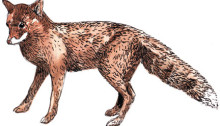Biologists excited by discovery of red foxes in Oregon
Not much is known about the rare subspecies
By Kyle Spurr, The Bulletin, @kylejspurr
Little is known about the Sierra Nevada red fox, a rare subspecies of the small mammal of which there are fewer than 50 living in Northern California.
But a recently discovered population roaming the Oregon Cascades has excited wildlife biologists, who believe they have found a larger population.
The biologists hope to learn more about the foxes after capturing and radio-collaring two this month in a high-elevation forest near Mount Bachelor.
The Oregon Department of Fish and Wildlife and Tim Hiller, a wildlife biologist and founder of the Wildlife Ecology Institute, began studying the Sierra Nevada red fox in 2012.
Through cameras and fur and scat collection, the study found the foxes living above 5,000 feet on Mt. Jefferson, Mt. Washington and in the Three Sisters Wilderness.
It’s not clear how many live in Oregon, how they use their habitat or how they interact with other foxes and coyotes, Hiller said. He plans to capture and radio-collar eight more foxes within a year to continue tracking them for the study.
“We don’t know their population status,” Hiller said. “Nobody has a clue.”
Hiller and Jack Vaughn, an ODFW wildlife technician, snowshoed into the forests of Deschutes County this spring to set traps for the foxes. They used roadkill deer, bottles of fox urine and skunk spray to lure the foxes into the cage traps, originally designed for bobcats.
“We usually smell like skunk,” Hiller said.
After resetting a trap May 1, Hiller and Vaughn returned the next day to find an 8-pound adult female Sierra Nevada red fox in the trap. She has a mixed color different from other Sierra Nevada red foxes, which have silver and black fur or red fur. Sierra Nevada red foxes are generally smaller than other red foxes, averaging about 8 pounds.
On May 10, Hiller and Vaughn caught a 10-pound adult male, also with a similarly colored coat.
Each fox was drugged and kept for about two hours while Hiller and Vaughn took fur samples and attached the radio-collars, which will stay on for one year. The foxes were then released at their capture site.
DNA samples are being sent to a laboratory at the University of California, Davis. Part of the laboratory work could confirm if the Oregon foxes are compatible with the dwindling California foxes, Hiller said.
“This is really far down the road, but we could see if the Oregon foxes are similar enough to the California foxes that we might be able to augment those populations,” Hiller said.
Sierra Nevada red foxes in California are on a waiting list for protection under the federal Endangered Species Act. The Oregon foxes are not close to being on a federal listing, but are an Oregon Conservation Strategy Species. Such species include those with small, declining or unknown populations that could be at risk and may be in need of conservation.
Within the conservation strategy, the Oregon Department of Fish and Wildlife has questions about the Sierra Nevada red fox, specifically about its population dynamic, genetic information, seasonal habitat use and how it competes with coyotes.
The ongoing study of the foxes will address these questions, said Hiller, who previously worked as an ODFW carnivore and furbearer biologist.
“We will continue to capture and collar them for at least another year,” Hiller said. “I intend to expand the project area and the duration of the project.”
— Reporter: 541-617-7820, kspurr@bendbulletin.com
Other pages in this section
*** previous title *** --- *** next title ***


